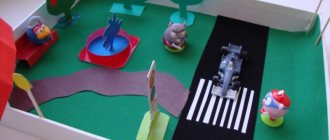What is the grammatical structure of speech
The grammatical structure of speech is the correct construction of speech (texts, sentences, dialogues).
The formation of grammatical structure occurs gradually. At first, children do not use prepositions in their speech, they may confuse the gender of the noun and place emphasis incorrectly. In the process of ontogenesis and normal speech development, vocabulary is enriched, new knowledge is acquired about the world around us, and sentences take on the correct form.
Therefore, teachers of preschool educational institutions are faced with the task of improving the grammatical structure of speech. More precisely, to help children understand the morphology, syntax and word formation of their native language.
How to form a grammatical structure of speech in preschoolers
The formation of the grammatical structure of speech in preschoolers is carried out according to several tasks:
- Formation of sentence structure. This task can be easily implemented based on the plots of various fairy tales. First, the teacher offers a fairy tale, and then the children try to compose a short retelling with the help of the teacher. The visual element of the work is also used - making sentences based on the plot depicted in the picture.
- Development of word formation. Word formation is a component of the grammatical aspect of speech that causes the greatest difficulties among preschoolers. Didactic games prove good effectiveness in this area. For example, exercise “Pets”. Children are invited to play and tell the composition of a family of domestic animals, what the cubs are called, and how they are useful in the household. Interesting tasks for this stage are those where you need to name a part or element of the whole.
- Development of coherent speech. In this task, the main activity is a role-playing game. Children need communication and building dialogue relationships. In such activities, children independently learn new techniques and means of communication.
Note! Thus, for the qualitative development of the grammatical structure of speech in children, communication with adults and peers is necessary. With the constant interaction of children with each other, non-forced and gentle development occurs.
Didactic games for the assimilation of animation and inanimateness
Didactic games are supplemented with games for mastering the category of animate-inanimate (“What (who) do we see?”, the imperative mood of the verb (“Bear, do it!”). Verbal exercises are introduced to consolidate the category of gender in nouns, agreeing adjectives with nouns, and using indeclinable names nouns, mixed verbs (to want and to run). For example: Big boy. How can you say about a girl? What is she like? What (who else) can you say big? Big? Big?
At senior preschool age, the assimilation of the native language system is completed. By the age of six, children learn the basic patterns of changing and combining words into sentences, agreement in gender, number and case. Only atypical forms cause difficulty. Children sometimes encounter errors in the alternation of consonants (“I AM vengeance and my vengeance is terrible”, in the use of nouns in the genitive case in the plural (“Don’t scare the ALIENS”, in the formation of the imperative mood of verbs (GO, LYE, LIE, STERI, TERI) and the comparative degree of the adjective and adverb (“This road is SHORTER”, “I WIPED my face DRY.”) Difficulties for the child are the combination of nouns with numerals (WITH TWO children, pronouns (THEIR yard, the use of participles (BROKEN, DRAWN, verbs want, run , call (THEY ARE RUNNING, HE WANTS, THEY CALL YOU).
The acquisition of grammar at this age is facilitated by the development of elements of logical, abstract thinking, and the formation of linguistic generalizations.
The tasks of this age stage are: to teach children to correctly change all the words in their active vocabulary, to cultivate in the child a critical attitude towards grammatical errors in his own and others’ speech, and the need to speak correctly. The role of didactic games with toys is reduced, pictures, verbal didactic games and special verbal grammar exercises are used more.
The second direction of work is the formation of the syntactic side of speech.
When working on syntax, the task of developing skills in constructing different types of sentences and the ability to combine them into a coherent statement comes to the fore.
As already indicated, the speech of 3-year-old children is situational, so it is necessary to teach the child to construct phrases from two or three words (simple sentences). In the fourth year of life, the ability to construct sentences of different types - simple and complex - develops. For this purpose, pictures, communicative situations, didactic games, and dramatization games are used.
In early preschool age, work on sentences takes place in the following sequence: first, children are taught to feel the basis of a sentence (subject and predicate), then distribute and grammatically formulate a simple sentence.
Word formation as a component of the grammatical aspect of speech
The word formation process, the formation of one word on the basis of another, is a rather complex process. It happens in several stages:
- first period (from 2.5 to 4 years). Words are formed accidentally, involuntarily;
- the second period (from 4 to 6 years), when there is an active accumulation of vocabulary and, at the same time, word production;
- the third period is the assimilation of rules and norms of speech.
Articulatory gymnastics for sounds “s, z, c”
Important! The active period of the word formation process is the age from 4 to 6 years and it is necessary not to miss this sensitive period. Underdevelopment of one of the stages leads to a decrease in the educational opportunities of the other. ONR is detected already in the early stages of development.
Factors influencing the development of grammatical structure of speech
Among the factors that influence the development of speech in preschool children, educational psychologists identify social and genetic factors.
- Social factors. Family plays an important role in social factors. In a complete family, children do not experience a lack of communication and constantly practice their speech needs. If a child is raised by a single parent, the possibility of communication is significantly reduced. The number of children plays an important role. Communicating with brothers and sisters at home, children can realize their interests in active and role-playing games. But at the same time, as psychologists note, families with many children devote slightly less time to reading than families with one or two children.
An important point in the development of speech remains the material resource of the family and the level of education of the parents. Fathers and mothers of high socioeconomic status have children with larger vocabularies as a result of parents' own use of grammatically correct sentences. Such parents can allow children to receive more information about the world around them, enriching and organizing the subject environment. Moreover, in families where a warm atmosphere and mutual understanding prevail, the child’s vocabulary takes on a more emotional character.
By attending a preschool educational institution, preschoolers expand their range of communications and gain positive communication experiences.
- Genetic factors. The successful development of parents has a beneficial effect on the development of speech skills in children. The level of intellectual development and the ability to successfully learn is inherited. Children whose mothers and fathers did well in school and have higher education learn basic grammatical principles of speech a little faster.
Psychological and pedagogical features of senior preschool age
Senior preschool age is the last stage of preschool age, when new formations are formed in the child’s psyche. This concerns the arbitrariness of mental processes - attention, memory, perception, etc. -which leads to the ability to control one’s own mental processes... - and with it the ability to control behavior, as well as changes in self-image, self-confidence and self-esteem. The emergence of will is a decisive change in the child’s activity, when he no longer sets himself the goal of changing external objects around him, but controls his own behavior.
Children of the sixth year have even greater physical and mental abilities than children of the middle group. They have mastered the basic movements. Physically the child is still stronger. Physical development is still linked to mental development. It becomes a necessary condition, a background against which the child’s comprehensive development successfully takes place. Intellectual, aesthetic, moral, that is, purely social, development is proceeding at a rapid pace.
At this stage of life, all aspects of the child's speech continue to improve. The child correctly pronounces all the sounds of his native language, clearly reproduces words, has the vocabulary necessary for free communication, correctly uses many grammatical forms and categories, his statements become more meaningful, expressive and accurate.
Communication emerges as a type of activity. In older preschool age, an extra-situational-personal form of communication arises, which is characterized by the need for mutual understanding and empathy, as well as personal motives for communication. Communication with a peer acquires the features of a non-situational nature, communication becomes non-situational and businesslike, and stable selective preferences are formed.
Personal development in older preschool age is characterized by the acquisition of new knowledge, the emergence of new qualities and needs. In other words, all aspects of the child’s personality are formed: intellectual, moral, emotional-volitional and practical. Soviet psychologists L.S. Vygotsky and A.V. Zaporozhets have repeatedly emphasized that in older preschool age the child moves from situational behavior to activities subordinate to social norms and requirements, and is very emotional about the latter. At this time, instead of the cognitive type of communication between the child and the adult, the personal type comes to the fore, in which interest in human interaction comes to the fore. A child of senior preschool age usually correctly knows what adults like and dislike in his behavior, and assesses the quality of his actions and the individual characteristics of his personality quite well. By the end of preschool age, children develop self-esteem. Its content is the state of the child’s practical abilities and moral qualities, expressed in submission to the norms of behavior established in a given group. In general, the self-esteem of a preschool child is very high, which helps him master new activities and, without doubts or fears, engage in developmental activities in preparation for school.
In children of this age, one can already observe manifestations of sincere care for loved ones, actions aimed at protecting them from fear and grief. A child acquires the ability to, to some extent, restrain stormy, violent manifestations of emotions; a 5-6 year old preschooler can hold back tears, hide fear, etc. He studies the “language” of feelings - socially accepted forms of expressing the subtlest nuances of feelings through gaze, facial expressions, gestures, postures, movements, intonations.
Designing, drawing, modeling are the most typical activities for preschool children. But at this age, elements of work activity are also formed, the main psychological meaning of which is that the child must understand that he is doing necessary, useful work for others. Self-care skills acquired at age five, outdoor experience, and handicrafts enable children to become more involved in adult activities. Older preschoolers can move from individual tasks to regular responsibilities: cleaning the play area, watering flowers, cleaning clothes and shoes.





